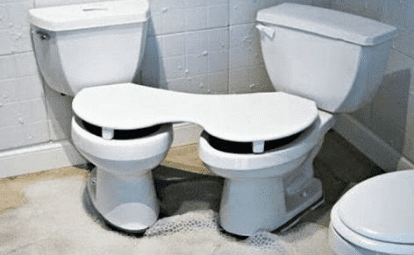Many of us often wonder, how do conjoined twins use the bathroom? Conjoined twins are a very rare type of twins with part of their bodies fused together. In many cases, the connection occurs between similar body parts, such as head to head, hip to hip, chest to chest, etc. However, the extent and location of the body fusion of conjoined twins may vary widely. It’s also common to have congenital anomalies (or birth defects) with conjoined twins.
The type of congenital disability depends on how the twins are conjoined. For example, the Hensel sisters typically shared a single lower body. Therefore, they would go to the bathroom together, like anybody else. However, some conjoined twins may have an issue going to the toilet, especially when one is placed in an uncomfortable position while the other is using the toilet.
In some cases, conjoined twins might have a bathroom built specifically to accommodate them. But some may be aided by using bedpans to allow them to go to the bathroom in any required position.
Types of Conjoined Twins
The exact medical terms used to describe conjoined twins are based on the location of the fusions. Common types of conjoined twins include:
- Omphalopagus twins are joined near the top of the belly button and may share parts of the body.
- Ischiopagus twins are joined at the pelvis. They are joined either facing each other or side by side. They share parts of the gastrointestinal tract, genital tract, urinary tract, and reproductive organs.
- Rachipagus twins are very rare. They are joined together at the back and along the length of their spine.
- Cephalopagus twins are joined at the top of the head and around a portion of their chest. They share their brain and other organs. They are single heads and only have one brain; they have heads that face opposite sides of the body.
- Cephalopagus twins are joined at the head and/or at the spine. They both have the same number of arms and legs but have separate brains.
- Craniopagus twins are joined at the back, top, or side of the head. They share a portion of the skull, but they have separate brains.
- Parapagus twins are joined at the trunk and appear side to side at the hips and thighs. They also join parts of the body (such as the intestines) and the chest (such as the stomach). They may have different muscles in their arms and legs, but they are normally composed of two heads.
- Pygopagus twins are joined at the back, in the middle of their bodies, or the buttocks.

Can Conjoined Twins Be Separated Through Surgery?
Children born as twins are usually delivered by a procedure called C-section, performed earlier than with full-term pregnancies. After the birth, doctors decide whether or not to attempt to separate them surgically; many factors determine whether or not to do this, including:
- The extent to which they share vital organs
- The type of reconstructive surgery needed
- The likelihood that separation surgery will be successful
Doctors must weigh these questions against the outlook, issues the conjoined twins would face, and the health and physical complications they may experience if they’re not surgically separated.
Prognosis and Life Expectancy of Conjoined Twins
The chances that conjoined twins will survive the full term of pregnancy depends on the extent to which they are fused and where they are incorporated. Many conjoined twins die before their due date or do not survive the first few days after birth. About 40 percent of twins who are born alive are stillborn.
Sometimes conjoined twins survive the pregnancy, and in some cases, the twins may be separated surgically. The birth defects may be severe and life-threatening, especially after surgery to separate the twins. Risk factors for pregnancy of conjoined twins include polyhydramnios (too much amniotic fluid in the womb), premature birth, and fetal death (or stillbirth).
